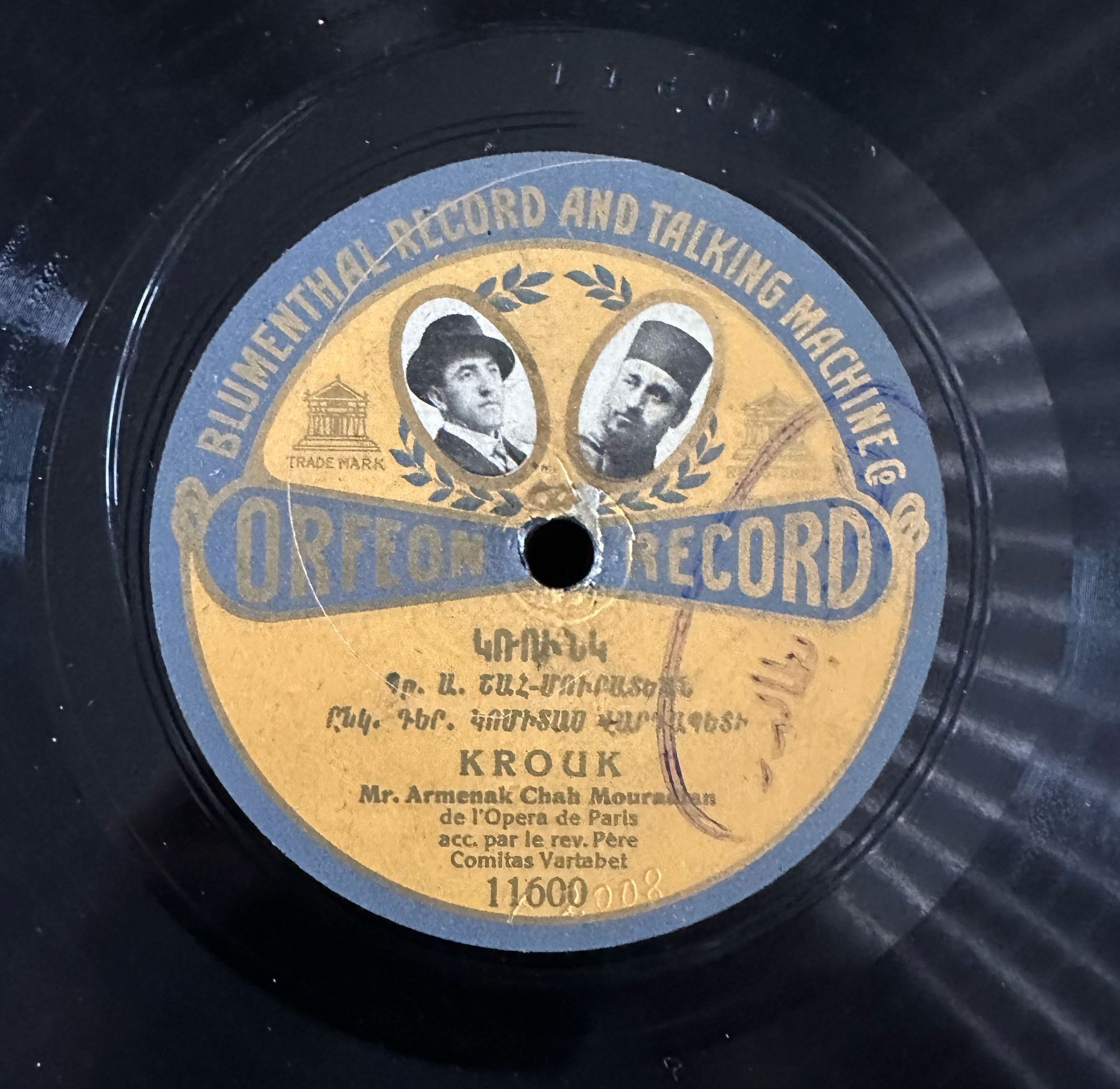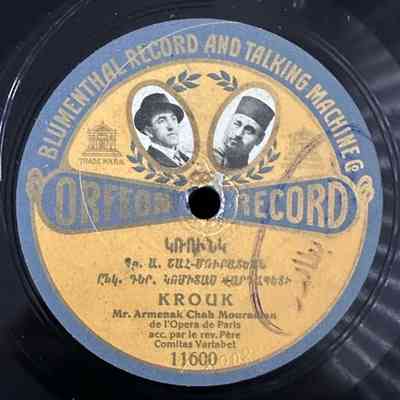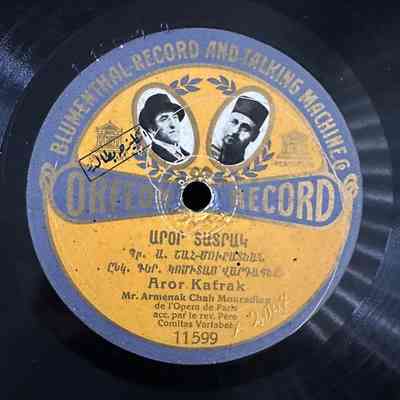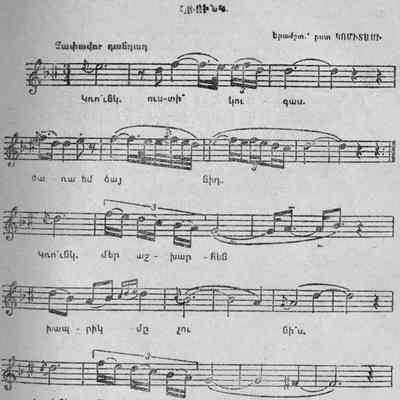Title
Aror DadragTrack Length
0:03:49Transcription
Արորն ասաց տատրակ հավքուն.
«Ինչո՞ւ կուլաս կուց-կուց արուն,
Երթա լցվի բարակ առուն»,
Տատրակն ասաց արոր հավքուն.
«Գընաց գարուն, եկավ աշուն,
Կըտրավ ջըրիկ աղբյուրներուն,
Կըտրավ խոտիկ ծաղիկներուն,
Կըտրավ ձենիկ կաքավներուն:
Էնքան պիտի լամ երերուն,
Արուն կաթե իմ աչքերուն,
Ես ի՞նչ անեմ իմ ձագերուն»:
Ասաց. «Դու մի լա էս աշուն,
Չէ՞, վաղ կուգա բարի գարուն,
Լույս կըբացվի վեր աշխարհուն,
Դուռ կըբացվի խեղճիկներուն,
Ես քեզ կառնեմ իմ թևքերուն,
Թըռնեմ բանձրիկ վեր սարերուն,
Բուն կըդնեմ մեջ քարերուն,
Տուն կը շինեմ մեջ գազերուն,
Երթիկ բանամ դեմ հով քամուն,
Թոնիր թաղեմ մեջ այրերուն,
Ծուխ կը հանեմ հետ ամպերուն,
Մեր ցավ կըտանք հարավ քամուն»:
Գընաց աշուն, եկավ գարուն,
Կաթեր ջըրիկ աղբյուրներուն,
Կերթար լըցվեր բարակ առուն:
Աղբըրանցարուն մեջ քարերուն,
Դեղին սուսուն վեր սարերուն,
Փունջ մանուշակ մեջ ձորերուն,
Կանաչ-կարմիր, գույն-գույն ծաղկունք,
Դաշտերն ամեն էրունք թըռչունք,
Ձենիկ կուգա գառնիկ մաքուն,
Մեր ապրելիք վեր երկընքուն:Track Notes
"Arorn u Tadrak" (The Crane and the Pheasant) features a dialogue between a crane (Arorn) and a pheasant (Tadrak), symbolizing themes of love, rivalry, or differing perspectives. Like many folk songs, it uses animals as metaphors to express broader human emotions such as yearning, loss, or beauty. The song's exact origin is unclear, but it is representative of Armenian folk music, characterized by lyrical, poetic elements and modal melodies. Traditionally, it would have been performed at gatherings or passed down orally in rural communities, with instruments like the duduk or saz often accompanying the singing. While it is not as well-known in the formal Armenian music canon, it remains an important part of the living oral tradition, conveying historical experiences like migration and exile. "Arorn u Tadrak" continues to be an example of how Armenian folk songs capture emotional and societal narratives.Title
KrounkTrack Length
0:03:21Transcription
Կռո՛ւնկ, ուստի կուգաս, ծաոա եմ ձայնիդ,
Կռո՛ւնկ, մեր աշխարհեն խապրիկ մը չունի՞ս,
Մի՛ վազեր, երամիդ շուտով կըհասնիս,
Կռո՛ւնկ, մեր աշխարհեն խապրիկ մը չունի՛ս։
Թողել եմ ու եկել մըլքերս ու այգիս,
Քանի որ ա՛խ կանեմ, կը քաղվի հոգիս,
Կռո՛ւնկ, պահ մի կացիր, ձայնիկդ ի հոգիս,
Կռո՛ւնկ, մեր աշխարհեն խապրիկ մը չունի՞ս։
Աշունն է մոտեցել, գնալու ես թետպիր,
Երամ ես ժողովել հազարներ ու բյուր,
Ինձ պատասխան չտվիր, ելար գնացիր,
Կռունկ, մեր աշխարհեն գնա՛, հեռացի՛ր։Track Notes
“Krunk” (meaning “Crane” in Armenian) is one of the most enduring and emotionally powerful pieces associated with Komitas Vardapet, the pioneering Armenian priest, composer, and ethnomusicologist who devoted his life to preserving Armenian folk music. While Komitas did not compose the lyrics, he collected and arranged the song in the early 20th century, transforming it into a refined art song while remaining faithful to its folk roots. His arrangement, typically for voice and piano or a cappella performance, is known for its haunting modal melody, subtle harmonic texture, and emotional depth—hallmarks of Komitas’s approach to sacred and vernacular music.
The origins of the text date back to the 17th century and are often attributed to the poet and cleric Mkrtich Naghash (or, in some versions, Naghash Hovnat’an). The lyrics are written from the perspective of someone in exile, who addresses a migrating crane flying toward Armenia, pleading with the bird to bring news from the homeland. This theme of longing and spiritual displacement is deeply embedded in Armenian cultural consciousness, especially within the context of diaspora and historical trauma.
The earliest manuscript of Krounk is preserved in Archbishop Artavazd Syurmeian’s "Catalog of Armenian Manuscripts in Aleppo" (Jerusalem, 1935, p. 334), and dates back to 1679. In 1847, the “Krunk” song was published in Venice in “Bazmavep,” marking the first printed version. The first recording was made by musicologist Grigor Galafyan, and an Armenian-French version was published in the “Krunk” bilingual magazine.
In Armenian symbolism, the crane represents the soul of the wanderer or exile—a messenger between the homeland and those forcibly separated from it. Komitas’s arrangement of “Krunk” resonates all the more powerfully given the historical context of the Armenian Genocide, which began in 1915. Komitas himself was deeply affected by these events, suffering a psychological collapse from which he never recovered.


